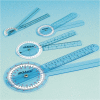Laparoscopic bridging vs. anatomic open reconstruction for midline abdominal hernia mesh repair [LABOR]: single-blinded, multicenter, randomized, controlled trial on long-term functional results
- PMID: 24165473
- PMCID: PMC4231609
- DOI: 10.1186/1745-6215-14-357
Laparoscopic bridging vs. anatomic open reconstruction for midline abdominal hernia mesh repair [LABOR]: single-blinded, multicenter, randomized, controlled trial on long-term functional results
Abstract
Background: Re-approximation of the rectal muscles along the midline is recommended by some groups as a rule for incisional and ventral hernia repairs. The introduction of laparoscopic repair has generated a debate because it is not aimed at restoring abdominal wall integrity but instead aims just to bridge the defect. Whether restoration of the abdominal integrity has a real impact on patient mobility is questionable, and the available literature provides no definitive answer. The present study aims to compare the functional results of laparoscopic bridging with those of re-approximation of the rectal muscle in the midline as a mesh repair for ventral and incisional abdominal defect through an "open" access. We hypothesized that, for the type of defect suitable for a laparoscopic bridging, the effect of an anatomical reconstruction is near negligible, thus not a fixed rule.
Methods and design: The LABOR trial is a multicenter, prospective, two-arm, single-blinded, randomized trial. Patients of more than 60 years of age with a defect of less than 10 cm at its greatest diameter will be randomly submitted to open Rives or laparoscopic defect repair. All the participating patients will have a preoperative evaluation of their abdominal wall strength and mobility along with volumetry, respiratory function test, intraabdominal pressure and quality of life assessment.The primary outcome will be the difference in abdominal wall strength as measured by a double leg-lowering test performed at 12 months postoperatively. The secondary outcomes will be the rate of recurrence and changes in baseline abdominal mobility, respiratory function tests, intraabdominal pressure, CT volumetry and quality of life at 6 and 12 months postoperatively.
Discussion: The study will help to define the most suitable treatment for small-medium incisional and primary hernias in patients older than 60 years. Given a similar mid-term recurrence rate in both groups, if the trial shows no differences among treatments (acceptance of the null-hypothesis), then the choice of whether to submit a patient to one intervention will be made on the basis of cost and the surgeon's experience.
Trial registration: Current Controlled Trials ISRCTN93729016.
Figures
References
-
- Wong SY, Kingsnorth AN. Prevention and surgical management of incisional hernias. Int J Surg Invest. 2001;3:407–414.
-
- Luijendijk RW, Hop WC, Van Den Tol MP, De Lange DC, Braaksma MM, Ijzermans JN, Boelhouwer RU, De Vries BC, Salu MK, Wereldsma JC, Bruijninckx CM, Jeekel J. A comparison of suture repair with mesh repair for incisional hernia. N Engl J Med. 2000;343(6):392–398. doi: 10.1056/NEJM200008103430603. - DOI - PubMed
Publication types
MeSH terms
Associated data
LinkOut - more resources
Full Text Sources
Other Literature Sources


